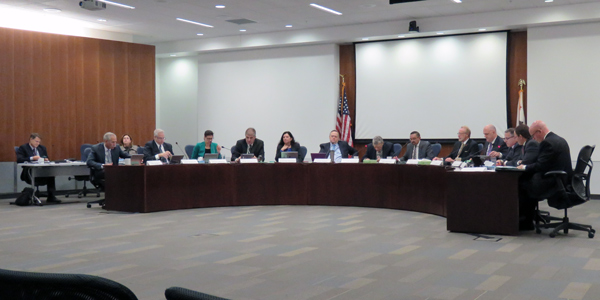By Jason Fordney
The CAISO Board of Governors last week enacted new governance policies and named Governor David Olsen as chairman. It also reviewed the ISO’s policy roadmap for 2018.
In a teleconferenced meeting Thursday, the board enacted a new process whereby governors will hold yearly elections for chair. The five-member board voted to replace sitting Chair Richard Maullin with Olsen, who was originally appointed to the board in 2012 by Gov. Jerry Brown.
Governor Angelina Galiteva said that with CAISO involved in more regional matters and the Western Energy Imbalance Market (EIM), the board felt members should have the opportunity to participate as chairs and share some of the growing workload. The board went through an analysis to study best practices, she said.
“This is something we thought over and talked about for quite a while,” Galiteva said. The board elected her to the newly created position of vice chair, nominated by Governor Mark Ferron and seconded by Governor Ashutosh Bhagwat.
“We are entering a period where there could be some rapid change we are part of or instrumental for,” Maullin said, as other board members thanked him for his service in his role. Maullin’s term on the board ended Dec. 31, and he said remaining on the board depends on the California State Senate, which confirmed him as chair in July 2015. He was reappointed by Brown in January 2015.
Cook Briefs Board on 2018 Roadmap
CAISO Director of Market and Infrastructure Policy Greg Cook briefed the board on the 2018 Policy Initiatives Roadmap and Annual Plan, saying the presentation to the board represents the final step in the implementation process.
In January, Cook briefed the EIM Governing Body on the plan, which includes a proposal to extend the ISO’s day-ahead market to the EIM. (See CAISO Plan Extends Day-Ahead Market to EIM.) Each balancing authority area would retain reliability responsibility, and states would retain control over integrated resource planning. Transmission planning and investment remains with each BAA and local regulatory authority.
Cook shared some of the tasks associated with the day-ahead market extension, including the alignment of transmission access charge paradigms to ensure EIM entities recover transmission costs consistent with the existing bilateral network, and consistent billing determinants across the day-ahead market footprint for market efficiency. There will also be distribution of congestion rents collected through the day-ahead market and a day-ahead resource sufficiency evaluation, among other requirements.
Keith Casey, the ISO’s vice president of market and infrastructure development, told the board that implementing the day-ahead across the EIM will provide additional benefits, but it “certainly will fall short of the full benefits we would get with full participation under a regional construct.” These would include efficiency of a single balancing authority over a larger footprint, as well as transmission planning and resource adequacy benefits.
“We believe it has important benefits … but I do want to stress it will fall short of the full integration benefits,” Casey said.
PG&E Continues Criticism of RMRs
During a public comment period, Eric Eisenman, director of ISO relations and FERC policy for Pacific Gas and Electric, told the board that PG&E has no issue with anything in the roadmap but that addressing the increasing use of reliability-must-run designations (RMRs) and the capacity procurement mechanism (CPM) is the utility’s “highest priority.” He reminded the board of the “robust discussion” it had over RMRs at its November meeting when the designation of the gas-fired Metcalf Energy Center was approved. (See Board Decisions Highlight Market Problems.)
“PG&E continues to be very concerned about a slew of RMRs for 2019 that would be designated later this year,” Eisenman said. “But at this point, we just don’t know what is going to happen.” He urged CAISO to implement more extensive “Phase 2” changes in its RMR/CPM initiative in time for 2019 designations. The ISO has indicated it only intends to address must-offer requirements for RMR and CPM units in that time frame.
Casey said the ISO is looking at transmission alternatives to prevent situations that might otherwise lead to RMRs, including working with PG&E to address “low-hanging, fast upgrades” in the subarea where the Metcalf plant sits. The improvements would alleviate about 600 MW of local capacity requirements and are included in a transmission plan due to be finalized in March, he said.
“There is much we can do — we have a great deal of flexibility with the transmission plans to do those types of studies,” but it would be challenging to complete the improvements by fall 2019, he said.
“We share PG&E’s urgency about getting after these RMR reforms,” Casey said.
CAISO is in the midst of developing a package of enhancements to the RMR/CPM process, which is proving to be a contentious proposal among market stakeholders. (See CAISO, Stakeholders Debate RMR Revisions.)





